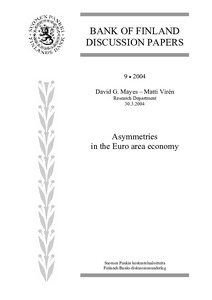Asymmetries in the Euro area economy
Mayes, David; Virén, Matti (30.03.2004)
Numero
9/2004Julkaisija
Suomen Pankki
2004
Julkaisun pysyvä osoite on
https://urn.fi/URN:NBN:fi:bof-20140807136Tiivistelmä
Using quarterly data for the period since 1987 this paper explores, in the context of a small model of the EU economy, the degree to which monetary policy has been asymmetric.It shows in particular that monetary policy has been much more responsive to threats that inflation would lie outside the price stability target than to equal sized shocks within the target zone. Similarly monetary policy has responded to threats of large positive and negative output gaps but has remained largely unresponsive to smaller divergences.It thus appears that the ECB and its predecessors have been avoiding 'fine-tuning' but have been aggressive in responding to substantial threats to macroeconomic stability.The action seems to have been stronger with respect to inflationary pressure than to deflation but this may offset any bias in fiscal policy.The asymmetric response of policy in part reflects considerable non-linearities and asymmetries in the behaviour of the euro area economies.High unemployment has relatively limited effect in pulling inflation down while low unemployment can be much more effective in driving it up.Economic downturns are both more rapid and sustained in driving unemployment up than recoveries are in bringing it down. There is considerable variety in these relationships and IS curves across countries, sectors and regions.Monetary policy reacts in the light of this. Key words: monetary policy, asymmetry JEL classification numbers: E52, E61
